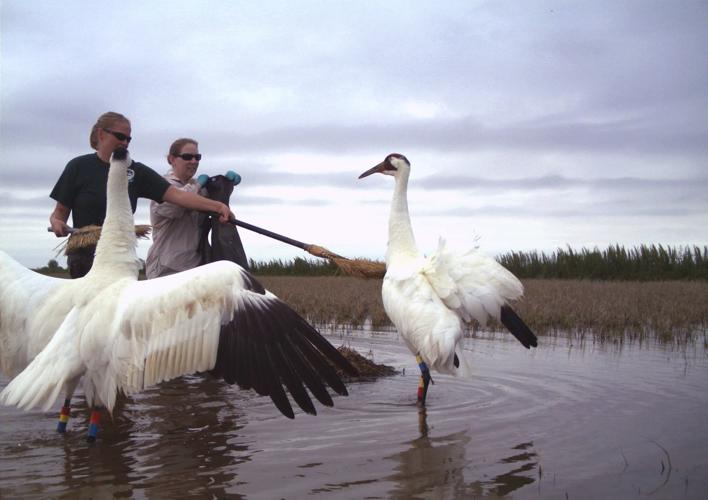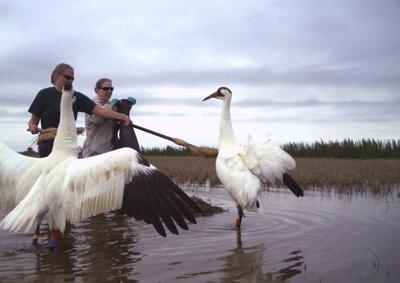In 2016, Kaenon Constantin and his nephew shot two cranes in Acadia Parish. Upon inspecting one of the birds, they discovered it had color bands and a transmitter on its legs. The bird was a whooping crane, the tallest bird in North America and among the most endangered.
Constantin and his nephew were unable to find the second bird. They took the first one home. There, they cut off its legs with a kitchen knife and threw the transmitter into a crawfish pond.
There have been more endangered whooping cranes shot in Louisiana than any other state. While poaching of all kinds of migratory birds in the state has drastically declined over the past 20 years, Louisiana still leads the nation in illegal bird shooting prosecutions. That further complicates the already-difficult process of saving endangered populations like whooping cranes.

At his sentencing hearing in Lafayette, Constantin apologized, calling his actions “ignorant and unnecessary.”
By killing two whooping cranes, Constantin further jeopardized efforts to build back the state’s population, driven to near extinction in the 1940s. Louisiana now has 80 birds in its flock, but 12 whooping cranes have been killed in Louisiana since the reintroduction program began in 2011. That means poaching accounts for almost 25% of the deaths in which a cause could be determined.
Wildlife advocates have been pressing the courts to hand down stiffer penalties for such crimes to deter people from continuing to illegally shoot birds. Poaching is a stain on the reputation of a state that proudly calls itself the “Sportsman’s Paradise,” said Danny Siefker, a federal prosecutor in the Western District of Louisiana.
State and conservation groups are pooling their money to offer a $10,000 reward for information about the still-unsolved shooting last year of…
“This is something that has to change,” he said. “If what they say is true about Louisiana leading the nation, it’s an embarrassment.”
In July, U. S. District Court Magistrate Judge Patrick J. Hanna ordered Constantin to pay a $10,000 fine and $75,000 in restitution to the Louisiana Department of Wildlife and Fisheries. He was also sentenced to five years of probation and 360 hours of community service.
Conservationists applauded the sentence, easily the stiffest one yet meted out for such a crime in Louisiana. The record had belonged to Lane Thomas Thibodeaux, who was ordered to pay a $500 fine and spend 45 days in jail for in 2014.
Constantin’s sentencing “sets a good precedent” in Louisiana, said Liz Smith, the International Crane Foundation’s North America program director. “Whooping cranes are a valuable part of Louisiana’s cultural and natural heritage, and people who choose to shoot them will face the consequences,” she said.
A Ville Platte man who pleaded guilty to illegally shooting an endangered whooping crane was sentenced to two years of probation and 120 hours…
Whooping cranes were nearly driven to extinction by overhunting and habitat loss. In the 1940s, fewer than 20 remained in the wild. Conservation efforts have slowly increased the species’ numbers. There are now about 670 whooping cranes in the world, including about 80 in the Louisiana flock.
But 12 cranes — more than one in seven in the flock — have been killed in Louisiana since the state started its reintroduction program in 2011. That’s more than in any other state, according to the International Crane Foundation. The Department of Wildlife and Fisheries has tried to raise awareness about the issue, placing anti-poaching messages on billboards in Alexandria, Lafayette and Lake Charles and broadcasting messages on television and radio.
But Lizzie Condon, an outreach coordinator for the International Crane Foundation, doesn’t think the outreach has worked. She believes that’s at least partly because sentences for poachers have been inconsistent.
“We’re continuing to send a message in Louisiana that you can get away with this,” she said.
A culture of poaching
While Louisiana is nicknamed the “Sportsman's Paradise," poaching has a long and rich history here. In the 1990s, Craig Forsyth, a sociology professor at the University of Louisiana at Lafayette, studied poaching in south Louisiana, interviewing dozens of hunters about their reasons for illegally killing birds.
Most poachers told Forsyth it was mainly for food. Wading birds, which live in wetlands and coastal environments, were most often targeted by poachers, especially yellow-crowned night heron, often called “grosbec” in Cajun French. During the 1920s, there was an open season on grosbec with a daily limit of 25 birds per day. While hunting of grosbec has been illegal in Louisiana since at least 1945, hunters continued to target the species anyhow.
A Ville Platte man is scheduled for a change-of-plea and sentencing hearing Friday for shooting an endangered whooping crane in 2018.
“I like to eat grosbecs,” one poacher told Forsyth. “If it’s good to eat, I shoot it, anytime.”
Forsyth predicted poaching would lose favor in south Louisiana as animal rights became more prominent and food assistance became more available. He was right. In 1998, there were more than 600 prosecutions in Louisiana for killing or possessing migratory birds illegally, according to Transactional Records Access Clearinghouse data.
Last year, there were less than 10.
Even so, the state has had more prosecutions for illegally killing or possessing migratory birds than any other state for the past five years. The state accounts for about half of the prosecutions under the Migratory Bird Treaty Act each year, the data show.
The southwest regional captain of law enforcement for Louisiana Wildlife and Fisheries, Jesse Savoie, said Louisianans have lost their taste for nongame birds, or birds that do not have a legal hunting season. While poaching continues in the state, the reason is not for food, he said.
If anything, the birds are shot because they’re viewed as competition for food, he said. In 2018, a Ville Platte man said he shot at a whooping crane in Evangeline Parish to flush it away from a crawfish farm.
Most of the Louisiana whooping crane population lives around the White Lake Wetlands Conservation Area, in Vermillion Parish. “A 5-foot bird that appears to be eating crawfish could be seen as a problem,” Savoie said. But there are too few whooping cranes in Louisiana to represent a real threat to agriculture, he said.
“Of course there’s going to be black bear conflict. But come on, whooping crane conflicts?” he asked. “Come on, no. There’s just no excuse for that.”
Rare bird, slow rebound
The reason whooping cranes remain so rare has to do with the way they reproduce. They don’t reach sexual maturity until they’re about 4 years old, said Sara Zimorski, a Wildlife and Fisheries biologist.
Once mature, whooping cranes mate for life, laying two eggs every year. Typically, only one chick survives. In order to increase the population, conservationists hatch eggs and raise chicks in captivity. The cost of raising, releasing and monitoring a whooping crane in Louisiana is about $94,000 per bird, according to the International Crane Foundation. The cost is covered by private, state and federal institutions.
NEW ORLEANS (AP) — Scientists are using fake eggs to spy on whooping cranes in hopes of learning why some chicks die in the egg, while others hatch.
Each bird killed thus represents a huge financial setback, Zimorski said. “It’s discouraging that it’s been such a high source of mortality,” she said.
Whooping cranes can be mistaken for sandhill cranes, but those are also illegal to shoot in Louisiana. “It’s not a case of mistaken identity during legal hunting activity,” Zimorski said. “It’s very much intentional. That’s a frustrating thing for me to understand.”
Last November, a whooping crane was killed in Jefferson Davis Parish. The case is under investigation. Stiffer sentencing should be considered, said Audubon Louisiana’s director of bird conservation, Erik Johnson.
“I don’t think this is going to be the last killing that we see,” he said. “We really need to use the fines to inform people who don’t necessarily know the value or the importance of each bird in this reintroduction program.”
The value of Louisiana’s whooping crane population goes beyond the investment made in each bird, Johnson said. Saving the species speaks to the slogan Louisiana’s features on its license plate. The state helped bring back the brown pelican and the American alligator from the brink of extinction. It also played a vital role in the recovery of the bald eagle, he said.
“Virtually anyone who sees a whooping crane in person their jaw drops. They’re so tall. They’re so faithful to each other,” Johnson said. “And I really, really hope more Louisianans have that opportunity to enjoy these birds.”








